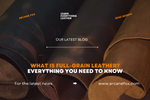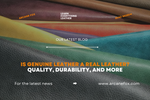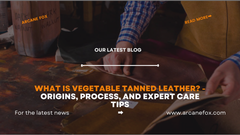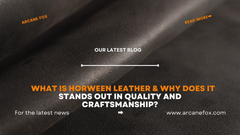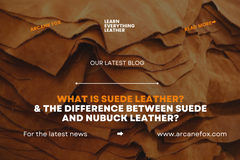What is Top Grain Leather? The Comprehensive Guide
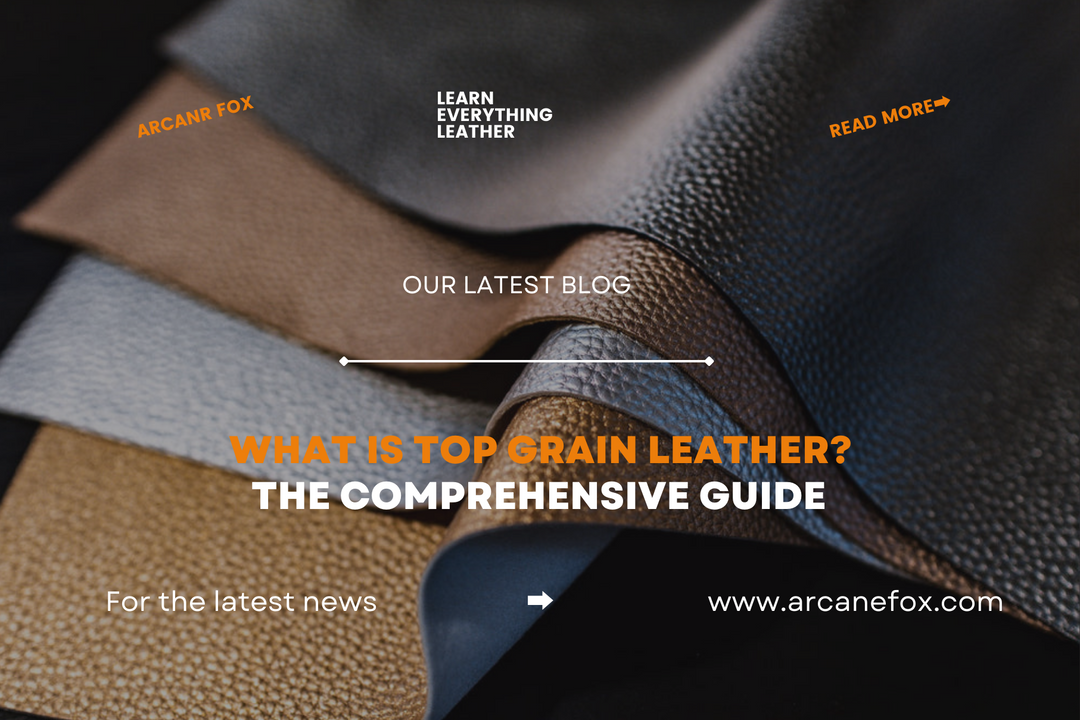
What is Top-Grain Leather? The Comprehensive Guide
Leather has long fascinated humanity with its ageless charm, a material that spans the gap between raw sturdiness and timeless elegance. "Top Grain Leather" is a term that is frequently used in the context of leather, although many people may not understand what it really means. In this thorough guide, we set out on a quest to debunk popular myths and misconceptions about top grain leather as well as explore its background, traits, and history.
We'll delve deeply into the world of Top Grain Leather, from the annals of leathercraft history to the contemporary workshops where artisans transform hides into stunning products. You'll learn about its advantages and disadvantages, learn about the complex manufacturing process, and investigate where and how it fits into the world of leathercrafting.
1. What Is Top-Grain Leather?

Top grain leather is made from a type of hide that has been modified to have fewer defects. A tannery will do this by shaving off the top layer of a hide to get rid of any inherent markings. Big bites, range markings, branding marks, and other potential defects fall under this category.
When top grain leather is remove from the surface, some durability and potential thickness are typically lost. In return, producers can turn severely faulty hides into a well-liked leather that competes with any other on the market.
2. Clearing Up Myths & Misconceptions
For some people, knowing that leather is "top grain" is reason enough to avoid a product. How to evaluate leather's quality is one of the biggest myths in the industry. There is a general principle that full grain is preferable to top grain. This oversimplifies their distinctions and ignores any disparities in quality.
Top grain leather is not necessarily inferior to full grain leather. The distinction is between what a customer appreciates and the tannery's quality. Full grain skins' markings, which are seen as rustic by many, are a detractor.
Top grain leather, on the other hand, will be regarde as refined and possibly more appropriate for luxury leather goods. Similar to top grain leather, a full grain hide that has undergone a low-quality tanning procedure would be less desirable than one that has.
3. History of Top-Grain Leather
In the course of time the use of different types of hides is trace to at least 5000 BC. The varieties of leather used in production began to expand among leather craftsmen in Egypt. They were able to offer more clothing to customers with all income levels through salvaging leather skins that were damage by scraping the layers off the skin.
Since then, top quality production of leather has increased significantly however the basic concept behind the material hasn't changed. Manufacturers are able to use the leather that is not suitable for production, and create cheaper alternatives by making use of top quality leather. This is a popular choice for products that are made of mid-priced leathers that are more readily accessible than premium leather.
4. Comprehensive Characteristics of Top-Grain Leather
4.1 Natural or Synthetic
When top grain leather is produce, the topmost layer of the hide is remove, but the leather is still natural. Top grain leather is 100% animal hide, similar to the complete leathers it is sometimes compare to, with the exception of the layer being remove for aesthetic reasons.
4.2 Surface Texture
The fashion industry uses a lot of top grain leather since it is the ideal material to impart different textures to. To mimic different kinds of animal hides, the clear surface might be embossed with bumps, patterns, or other textures. Top grain leather has a smooth texture and little variations across the hide when it is left alone.
4.3 Available Thickness
Top grain leather is generally offer in hides that range between 3 and 12 ounces (1.2mm-4.8mm) This means the leather comes in a wide variety. It's ideal for projects with thin edges such as wallets, and more substantial belts.
While leather can be relatively thick, it may not have as much thickness as the other. In the process of manufacturing, the hide's surface is remove which can drastically reduce the thickness, based on the amount of material removed.
4.4 Largest Workable Size
You can find hides for high grain leather in sizes up to 25 square feet. For huge cowhide leather components, this is a typical size. Large top grain pieces work well for upholstery, clothes, and bags. Only the thickness of top grain leather hides changes when the surface layer is remove.
4.5 Flexibility
Although flexibility between different top grain leather hides will differ, most will be more flexible than other leather types. This is due to the firm outer layer of the leather being remove when making top grain leather, reducing the density of the material and making it more supple. In addition, top grain leather is often tanned using chromium, which will also help break down the leather’s fibers.
5.6 Softness

The suppleness of top grain leather is average. The tanning procedure has the biggest impact, even though removing the top layer does make the leather more supple. As a result, it is typical to find top grain leather that is both soft and hard.
4.7 Sewability
Those who have dealt with various leathers before should feel comfortable sewing with top grain leather due to its good sewability. Although the leather is significantly more supple, it nevertheless maintains an average density to preserve its shape during stitching and allows needles to flow through effortlessly. Thin or textured top grain leather could be a little trickier to stitch.
4.8 Durability
Since the densest section of the leather is removed, top grain leather's longevity is frequently questioned. As a result, holes may form more quickly and the surface is more susceptible to damage. Therefore, low-wear items are where leather works best. Despite these possible drawbacks, leather exhibits commendable endurance, resulting in products with a long lifespan.
4.9 Ease of Maintenance
The ease of maintenance is one advantage that attracts many people to top grain leather. In order to stabilize the grain and prevent damage, top grain leather frequently has a robust protective coating applied. Top grain leather is less susceptible to sun damage than other leathers and does not scratch readily.
4.10 Lifespan with Daily Use
Although top grain leather's performance on high-wear leather items is impact by its durability, most projects ought to last for decades. Top grain leather, like all other forms of leather, benefits immensely from proper maintenance. The longevity of top grain leather can be compare to that of full grain leather under ideal conditions.
4.11 Available Colors
The large range of colors available in top grain leather is another excellent feature. Contrary to most leathers, which tend to remain with earth tones, top grain leather shines in color, offering a variety of patterns, colors, tones, and prints.
4.12 Waterproofness
Although not waterproof, top grain leather offers some water resistance. How water-resistant the leather is made depends on the process. Short exposure, though, won't often harm the body. On the other hand, excessive saturation or prolonged exposure could result in the leather losing its shape or being discolored.
4.13 Cost
Most of the time, skins that are select for top grain leather are unsuitable for other leathers. These hides can be use to manufacture top grain leather at a lesser cost while maintaining product quality. The leather is an excellent option for the majority of leather projects because it costs, on average, $4–$12 per square foot.
4.14 Ease of Crafting
Working with top grain leather is a terrific experience. The leather is frequently soft enough to be use for a variety of leather tasks while being stiff enough to allow for simple cutting and sewing. The only circumstance in which working with top grain leather might be challenging is if the leather has been given a texture. It may be challenging to keep a blade straight or punch through a lumpy surface because many top grain leathers have extra roughness.
4.15 Rarity (Common or Exotic)
One common method of salvaging skins is top grain leather. According to estimates, top grain leather is produce on a yearly basis in excess of 7 billion square feet. Due to its cheaper cost without sacrificing several desirable leather properties, this leather is produce and use all over the world.
Because of its lower price, leather is now more affordable to a larger group of people shopping for leather goods. As a result, the substance is a very well-liked option for producers of mid-range leather goods.
5. Pros of Top-Grain Leather

Top-grain leather is a premium material with a number of benefits that make it a popular option for many items. The following are some advantages of top-grain leather:
- offered in a range of hues and textures
- has a surface that is more uniform.
- Simple to work with Cheaper
- easily reachable
Check out this useful video from Buffalo Jackson Trading Co. for a better understanding of the applications for which top grain leather shines.
6. Cons of Top-Grain Leather
Your particular requirements and tastes will determine whether top-grain leather is the best option for you. Top-grain leather provides several benefits, but there are also some potential disadvantages to take into account:
- a thin thickness
- doesn't tarnish
- less resistance to scratches
- prone to dryness more
- less robust
The defects and marks will be remove by tanneries to produce consistent skins. This may have an impact on the leather's tensile strength and potential thickness.
7. How Top-Grain Leather is Made?
Starting with salted animal hides for preservation, top grain leather is then sent to various tanneries. The skins are wash at the tannery before being treat. Usually, the leather's surface is just clean of its hair. To create top grain leather, the hides are slightly deeper shaved, removing the top layer of flesh to create a surface that is more imperfection-free.
In order to address any lingering faults on the hide, this phase could also involve mild sanding or buffing. After being chopped down, the leather is placed in a tanning vat where different tannins penetrate the hide, conserving, preparing, and softening the material all at once.
Depending on the maker, the tanned leather may have a texture stamped on it or may have dye applied to it to give it color. These procedures can be finished up with the addition of a finishing coat before exporting the leather.
8. When You Might Used Top-Grain Leather in Leathercraft
Due to its blend of longevity, look, and price, top-grain leather is a flexible and well-liked option for leathercraft tasks. The following typical leathercraft tasks call for the use of top-grain leather:
- When creating a project that needs a consistent surface
- when using leather that is of higher quality but costs less than other leathers
- When seeking durable leather in a wide range of hues and textures
9. Tips for Leather Crafting With Top-Grain Leather

Top-grain leather working can be a fulfilling and fun hobby or vocation. Following are some suggestions for working with top-grain leather to help you achieve the finest results:
- When creating, take extra care to avoid scratching the surface because it can be impossible to repair.
- To make the cleanest cuts or holes in the leather, always use sharp instruments.
- Working with textured top grain leather will help you eliminate bumps by cutting and punching from the back.
10. Some Examples of Items Made From Top-Grain Leather
Due to its strength, appealing appearance, and soft feel, top-grain leather is a versatile material use to make a variety of products. Examples of objects frequently created from top-grain leather are provided below:
- Bags
- Garments
- Wallets
- Belts
- Footwear
- Watch straps
- Gloves
- Journal covers
11. Our Research on Top-Grain Leather
A frequent query is, "What is the best way to maintain them?" Top grain leather is use in many leather products found in stores. There are a few important distinctions to always keep in mind when handling top grain leathers as opposed to other leathers, in my experience working with and owning a variety of top grain leather hides.
11.1 Soaps and Scrubbing
A texture will typically be given to most top grain leather hides, which might make it simple for a lot of debris to become stuck in. Although leather may be cleaned in the same way as other materials, it is still a good idea to understand how the leather responds. Top grain leather is somewhat stain resistant compared to other hides. As long as the leather does not get sopped, building up a lather on an item can be an excellent solution for difficult stains.
Top grain leather, on the other hand, does not tolerate scuffs or other stains well. Any abrasion on a cloth will probably leave a mark on the leather. Often, cotton is the ideal material to use for this procedure. Alternatively, our hands offer reliable cleaning instruments for leather. It is an excellent way to clean top grain leather without damaging it, despite being filthy.
11.2 Slow Saturation
Many top grain leather products have cracked in my presence due to dryness. When questioned about their methods for curing leather, many will frequently have a reliable procedure. Frequently, this causes misunderstanding as well as frustration. Top grain leather still has pores, but when the leather is very dry, it is harder to get the product to penetrate into the leather.
I applied a drop of conditioner to both hides to evaluate the speed of full grain leather and top grain leather. The substance was absorb into the full grain leather within minutes, and it took around 10 minutes for it to completely penetrate the leather without any help. On the other hand, top grain leather moved far more slowly.
Before it became thin enough to pass through, the leather conditioner gradually covered the entire surface. Before it completely sank into the leather, it took more than twice as long, or 27 minutes. This shows the difference that may be made when top grain leather is treated with a leather conditioner. To ensure that the leather benefits fully from the applied conditioner, patience is essential.
11.3 Misshapen Leather
Poor storage, which results in a deformed item, is another typical problem I discover people have with top grain leather. Fortunately, dampening the leather allows for a decent amount of restoration. Top grain leather can still be useful in most circumstances even though it does not mold as easily. The leather should be dampened before being stuff with newspaper to keep the shape in place.
By absorbing the moisture with paper, the leather will not break. The item should be left to dry overnight after being stuffed. The leather needs to be conditioned after drying, and the filling should be taken out. The thing should continue to be in the desired shape. Repeat this procedure as often as required, being careful not to oversaturate the leather.
12. Conclusion
Despite the widespread availability of top grain leather, the majority of literature on leather care is focused on full grain leather. The same principles may still apply to top grain leather, but by making certain modifications, owners of top grain leather can customize upkeep to the leather and maintain their hides as spotless as possible.
Learn more about leather here: Leather 101 - The Ultimate Guide to Different Types of Leather
Related Posts:
What is full-grain leather? Everything You Need to Know
Is Genuine Leather a Real Leather? Quality, Durability, and More
The Comprehensive Guide to Split Grain Leather - Definition, Varieties, and More
What is The Difference Between Bonded Leather And Other Types of Leather

